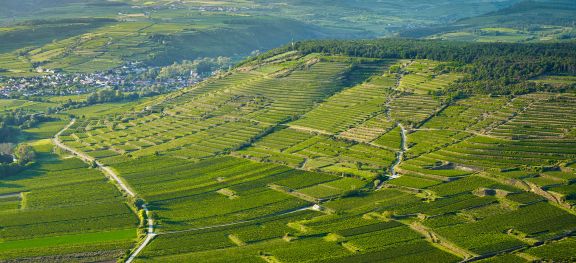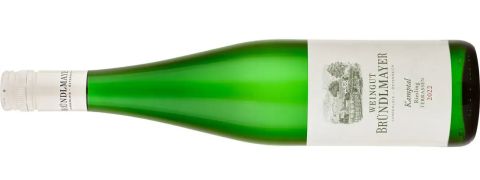Bründlmayer, Terrassen Riesling 2022 Kamptal

An Austrian Riesling to usher in spring, and to drink well beyond then, at a great price. Above, the terraced vineyards from which this comes.
Last week, Sam mentioned a wine she found so good that she was tempted to abandon her work and run off with the bottle.
This is one of those wines.
Bründlmayer has been one of the top wineries in Austria for decades, so it wasn’t entirely a surprise. The estate, based in Langenlois, includes some of the most sought-after land in Austria’s Kamptal region. And Willi Bründlmayer has been widely regarded as one of the region’s old-vine saviours since he took over the family winery in 1981. There hasn’t been a chemical herbicide or pesticide used here since 1979; the year after Bründlmayer took over, he began testing out biodynamic practices (never mind that it was one of the most challenging vintages on record). The estate and its vineyards have been certified organic by LACON since 2015.
Grüner Veltliner tends to be the calling card, both of the region (where it makes up 55% of plantings) as well as at the estate (33% of its 93 planted hectares/230 acres). The variety grows on all sorts of soils but it particularly likes to sink its roots into cushy, water-retaining loess soils. Bründlmayer has some top Grüner Veltliner sites, such as Käferberg, Spiegel and, most famously, Lamm, known for its powerful, rich renditions.
So when I had a chance to taste through a handful of Bründlmayer’s new releases last week, I had Grüner on my mind. And indeed a wine like his 2023 Terrassen Grüner Veltliner, pulled from the younger vines in his terraced vineyards, perfectly captures what Kamptal does so well: richly fruited, plush-textured, invitingly plump-yet-structured white wine.
But then there was the Bründlmayer, Terrassen Riesling 2022. I expected a reset but not like this. It hit like a bolt of lightning, brightening the room, intensifying all the senses. The person standing next to me started humming with pleasure. It made us laugh and want to kick off for the rest of the day. This wine is electric. Or, as I wrote in my tasting note:
Juicy and lively with bright, zingy acidity, this bursts with fruit, from limey citrus to peach and succulent passion fruit. The crisp acidity snaps it to the palate and holds the flavours long; the light grape-skin spice and saline mineral notes make it extra palate-whetting. It feels joyful and exciting, as effective in waking up the senses as caffeine. VGV (very good value)
Thomas Klinger, the estate’s ever cheerful and long-running marketing manager who was pouring the wine, smiled and said, ‘Riesling’s bad flowering was its advantage. There was not rot, and there was no overconcentrating.’ Later, via email, Andreas Wickhoff MW, general manager, explained that the growing season had got off to a rocky start, recalling it as ‘a vintage with a very dry start which was then however compensated during spring and also during the later stages of flowering where later flowering/ripening grapes such as Riesling “suffered” from irregular fruit set.’
He put ‘suffered’ in quotes, though, as, he explains, ‘the really tricky part about the vintage was the start. Cool, rainy periods were the norm every week until early October and therefore, getting ripeness in Grüner Veltliner was really challenging.’ Although they do a draconian selection in their Erste Lagen – the term used here to denote premier cru vineyards (more on that classification here) – Wickhoff recalled that, ‘even then, we had issues in receiving the right balance of fruit concentration, expression and a high (malic) acid value … Riesling, however, had overall less fruit set from the early days and therefore ripened more homogeneously and without any high disease pressure as bunches were loose.’
The quality and cleanliness of the Riesling was, in fact, so outstanding, he says, that ‘we had picked Ried Heiligenstein, for instance, in the shortest period of time I recall in the past 7–8 years due to little or no sorting out rotten berries in the vineyard’. For the Terrassen Riesling, they hand-picked grapes from two of their Erste Lagen, Ried Steinmassl and Ried Heiligenstein, as well as Ried Steinberg (‘north-west of Steinmassl, great future site, also paragneiss based, even cooler’, says Wickhoff; see also this map).
In the winery, the fruit was pressed as usual: in whole bunches, with very gentle pressure. (‘My goal is to get a very clean must for fermentation.’) Fermentation happens in stainless-steel tanks at 15–20 °C with ambient yeasts, and the wines are left on the lees until bottling. It’s bottled with a screwcap, another move to preserve freshness and clarity.
So the wine went into the bottle as clean and fresh as the grapes came off the vine, just with the advantage of time to organise itself, build some complexity and pull some extra structure and texture out of the lees. The wine is obviously delicious now, and hard to resist, but it has the structure to age well, too, for at least another five years, maybe 10. And given that it’s widely available for less than €13 in Austria and Germany, and as low as $25 (at Hi-Time Wine Cellars in southern California) or £22.95 in the UK via NY Wines of Cambridge (£128 for a case of 6), this is a steal.
Bründlmayer also has a handy directory of stockists around the world.
Members of JancisRobinson.com can access many more notes on Bründlmayer’s wines here.
Photo at top by Herbert Lehmann courtesy of Weingut Bründlmayer.
Become a member to view this article and thousands more!
- 15,408 featured articles
- 275,024 wine reviews
- Maps from The World Atlas of Wine, 8th edition (RRP £50)
- The Oxford Companion to Wine, 5th edition (RRP £50)
- Members’ forum
- 15,408 featured articles
- 275,024 wine reviews
- Maps from The World Atlas of Wine, 8th edition (RRP £50)
- The Oxford Companion to Wine, 5th edition (RRP £50)
- Members’ forum
- 48-hour preview of all scheduled articles
- Commercial use of our wine reviews



